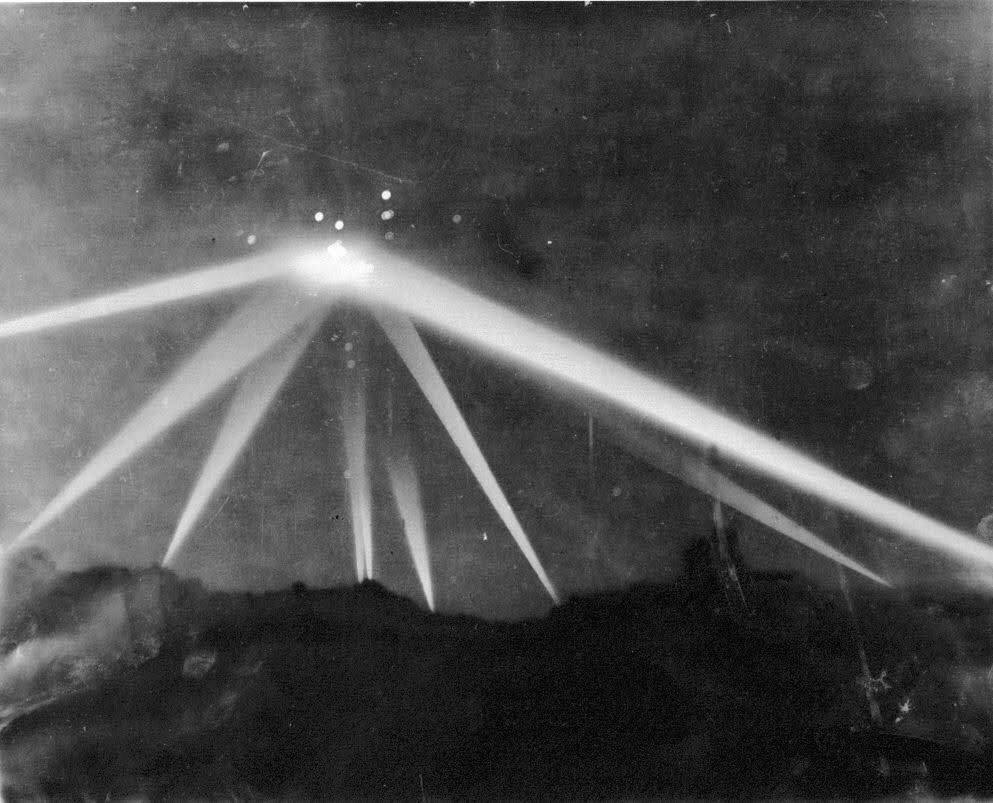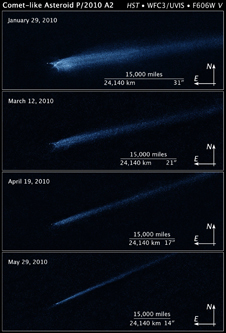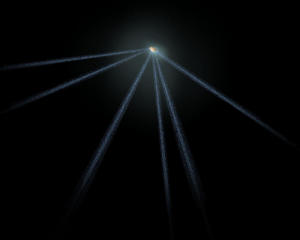It looks like you're using an Ad Blocker.
Please white-list or disable AboveTopSecret.com in your ad-blocking tool.
Thank you.
Some features of ATS will be disabled while you continue to use an ad-blocker.
share:
Science paper, if anyone interested: arxiv.org...
The Extraordinary Multi-Tailed Main-Belt Comet P/2013 P5
Hubble Space Telescope observations of main-belt comet P/2013 P5 reveal an extraordinary system of six dust tails that distinguish this object from any other. Observations two weeks apart show dramatic morphological change in the tails while providing no evidence for secular fading of the object as a whole. Each tail is associated with a unique ejection date, revealing continued, episodic mass loss from the 0.24+/-0.04 km radius nucleus over the last five months. As an inner-belt asteroid and probable Flora family member, the object is likely to be highly metamorphosed and unlikely to contain ice. The protracted period of dust release appears inconsistent with an impact origin, but may be compatible with a body that is losing mass through a rotational instability. We suggest that P/2013 P5 has been accelerated to breakup speed by radiation torques.
Now for replies:
Sirius b is too small and too far away to be visible to the naked eye anyway, you need a large telescope to see it. And it has been seen, by the Hubble, in visible spectrum: www.spacetelescope.org... It emits its own light, so there's no need for it to be illuminated by Sirius. And at over 8 light years away, it's way too far for its magnetic field to influence the Solar System in any way.
Anyway, bad example. I'd image that something that influences a single asteroid in the asteroid belt would have to be much closer to it, at least definitely within the Solar System (and thus illuminated by the Sun).
"If the mystery object's magnetic field is powerful enough, its possible for light to be obscured." - erm, how the hell can a magnetic field obscure light?
That example was the result of asteroid collision, so it's different from this particular example. The loss of material through rapid spinning might have been suggested before, but I'm not aware of any actual observations of this happening. So it's a first, and as it is always the case in science, further observations and measuremets are needed to say anything with certainty.
The Extraordinary Multi-Tailed Main-Belt Comet P/2013 P5
Hubble Space Telescope observations of main-belt comet P/2013 P5 reveal an extraordinary system of six dust tails that distinguish this object from any other. Observations two weeks apart show dramatic morphological change in the tails while providing no evidence for secular fading of the object as a whole. Each tail is associated with a unique ejection date, revealing continued, episodic mass loss from the 0.24+/-0.04 km radius nucleus over the last five months. As an inner-belt asteroid and probable Flora family member, the object is likely to be highly metamorphosed and unlikely to contain ice. The protracted period of dust release appears inconsistent with an impact origin, but may be compatible with a body that is losing mass through a rotational instability. We suggest that P/2013 P5 has been accelerated to breakup speed by radiation torques.
Now for replies:
BELIEVERpriest
reply to post by wildespace
Sirius b is invisible to the naked eye. Not even the light of its companion sirius a can illuminate it.
If the mystery object's magnetic field is powerful enough, its possible for light to be obscured.
Sirius b is too small and too far away to be visible to the naked eye anyway, you need a large telescope to see it. And it has been seen, by the Hubble, in visible spectrum: www.spacetelescope.org... It emits its own light, so there's no need for it to be illuminated by Sirius. And at over 8 light years away, it's way too far for its magnetic field to influence the Solar System in any way.
Anyway, bad example. I'd image that something that influences a single asteroid in the asteroid belt would have to be much closer to it, at least definitely within the Solar System (and thus illuminated by the Sun).
"If the mystery object's magnetic field is powerful enough, its possible for light to be obscured." - erm, how the hell can a magnetic field obscure light?
alfa1
Here's an older example from 2010.
An asteroid losing dust.
link
That example was the result of asteroid collision, so it's different from this particular example. The loss of material through rapid spinning might have been suggested before, but I'm not aware of any actual observations of this happening. So it's a first, and as it is always the case in science, further observations and measuremets are needed to say anything with certainty.
edit on 8-11-2013 by wildespace because: (no reason
given)
Seems to be a lot of old farts on here.....
its a rave, dont you know.
Thats an alien strobe light.
Sheesh......
its a rave, dont you know.
Thats an alien strobe light.
Sheesh......
The cause of this effect is likely to be something as mundane as a pressure differential within the asteroid.
As the Asteroids collide within the field they often break into smaller pieces, some of which are ejected from the field and fall inwards.
Some of those asteroid may in effect be nothing more than just big frozen dust balls encased in rock. However, the tails we see here are more likely caused by a higher pressure interior forcing material from the inside of the asteroid out into space.
The pressure doesn't even need to be very high, to be sucked out into a vacuum, it could be as little as 0.000001% of vacuum to be able to eject material.
This is my guess as to what is happening here.
Why don't we see this often?? Well I would say that the makeup of this asteroid with hard shell and soft interior is probably quite rare, as it does not conform with the norms. You would normally expect the core to be denser than the outer material.... though physics does allow an object such as I have described only if the interior were to be pressurized.
Peace,
Korg.
As the Asteroids collide within the field they often break into smaller pieces, some of which are ejected from the field and fall inwards.
Some of those asteroid may in effect be nothing more than just big frozen dust balls encased in rock. However, the tails we see here are more likely caused by a higher pressure interior forcing material from the inside of the asteroid out into space.
The pressure doesn't even need to be very high, to be sucked out into a vacuum, it could be as little as 0.000001% of vacuum to be able to eject material.
This is my guess as to what is happening here.
Why don't we see this often?? Well I would say that the makeup of this asteroid with hard shell and soft interior is probably quite rare, as it does not conform with the norms. You would normally expect the core to be denser than the outer material.... though physics does allow an object such as I have described only if the interior were to be pressurized.
Peace,
Korg.
edit on 8-11-2013 by Korg Trinity because: (no reason given)
Great find S+F
I just love Space stuff.
One thing I am wondering though, if it is spinning aroung in the asteroid belt, isn't there a risk of it colliding with other rocks/debris in there and throwing them out of orbit and perhaps toward us? Not trying to fear monger at all but isn't this a possibility?
I just love Space stuff.
One thing I am wondering though, if it is spinning aroung in the asteroid belt, isn't there a risk of it colliding with other rocks/debris in there and throwing them out of orbit and perhaps toward us? Not trying to fear monger at all but isn't this a possibility?
AbleEndangered
Its like this one.
It too had 6 tails and did fly by of Earth.
Wikipedia Reference Great Comet of 1744
en.wikipedia.org/wiki/Great_Comet_of_1744
en.wikipedia.org...
or one of other multi-tailed comets recorded by Ancient Asians.
edit on 8-11-2013 by AbleEndangered because: tweak edit
As you just said, though, those were comets. Not asteroids still in the asteroid belt.
reply to post by Teye22
I think that's a possibility for any asteroid in the belt if its acted upon somehow by either a collision or some gravitational pull.
In relation to this asteroid, I may have just been making an assumption or reading between the lines, but I saw it as spinning on its own sort of "axis".
Of course as all assumptions this could be wrong.
Should be interesting to see what more they find out about this.
One thing I am wondering though, if it is spinning aroung in the asteroid belt, isn't there a risk of it colliding with other rocks/debris in there and throwing them out of orbit and perhaps toward us? Not trying to fear monger at all but isn't this a possibility?
I think that's a possibility for any asteroid in the belt if its acted upon somehow by either a collision or some gravitational pull.
In relation to this asteroid, I may have just been making an assumption or reading between the lines, but I saw it as spinning on its own sort of "axis".
Of course as all assumptions this could be wrong.
Should be interesting to see what more they find out about this.
edit on 11/8/2013 by Chamberf=6 because: sp
Can anyone locate any animated models of a rotating and oscillating gaseous sphere for comparison purposes?
tokejesus
reply to post by Chamberf=6
Yeah, it was all over the news. Google it, many sources.
That was an instance of different circumstances and there has been more time to study the information from it, if you are speaking of the 2010 asteroid mentioned in an earlier post.
This occurrence is a new type of observation with different properties yet to be fully understood or explained fully.
edit on 11/8/2013 by
Chamberf=6 because: (no reason given)
Has anyone else noticed that it seems to be 3 pairs of almost right angled releases in one of the pictures?
reply to post by ergot
Hadn't noticed, but that IS kind of weird. Since it is spinning/oscillating maybe it's just the view at the moment of the picture?
Hadn't noticed, but that IS kind of weird. Since it is spinning/oscillating maybe it's just the view at the moment of the picture?
I can't believe this thread doesn't have more flags, stars, and ATS member input, especially since it's an anomaly acknowledge through reputable
sources and through the Hubble telescope.
Maybe everyone is so overwhelmed their brains have stopped working and they forgot how to speak.
Maybe everyone is so overwhelmed their brains have stopped working and they forgot how to speak.
Some different info from finally a different article.
Not containing ice sort of surprised me, and thought that "continuing activity at the nucleus" was interesting.
io9.com...
and
arxiv-web3.library.cornell.edu...
The configuration of these tails changed dramatically during the course of the observations. At the same time, however, the astronomers also noticed that the comet's core was not degrading at a noticeable rate. The angle of each tail could be traced back to a different time of cometary ejection over a five month span (dating back to April). This is a good sign that there's continuing activity at the nucleus.
Observations also showed that P/2013 P5 is unlikely to contain ice. The astronomers don't think it came from the Kuiper belt or the Oort cloud. Its orbit is located near the inner edge of the asteroid belt, in the neighborhood of the Flora family of S-type asteroids. These bodies are primarily made from stone, containing lots of iron. So the six-tailed comet isn't likely to contain water ice
Not containing ice sort of surprised me, and thought that "continuing activity at the nucleus" was interesting.
io9.com...
and
arxiv-web3.library.cornell.edu...
edit on 11/8/2013 by Chamberf=6 because: (no reason given)
InTheLight
Can anyone locate any animated models of a rotating and oscillating gaseous sphere for comparison purposes?
Well, I think it may have to do with it's shape. We really don't have a lot of close up pics of comets to determine what their shape has to do with their behavior in rotation or oscillation. Here's a vid with a close up pic of an oddly shaped comet. I wonder if this comet has six irregularly shaped projections on it's surface?
"...It's hard to believe we're looking at an asteroid."
I don't have to say it, do I? (aliens) Just kiddin', who knows for sure. Fascinating and bizarre discovery nonetheless.
Great find op, flag for you. This is conjunction with comet Ison's alleged strangeness and things in the heavens are pretty interesting these days.
edit on 8-11-2013 by Runciter33 because: (no reason given)
All Seeing Eye
Looks absolutely Divine. Say, where is this "Thing" , in relationship with Ceres?
I would think it's relation to Ceres would change constantly.
As they revolve around the sun in elliptical orbits, the asteroids also rotate, sometimes quite erratically, tumbling as they go.
solarsystem.nasa.gov...
edit on 11/8/2013 by Chamberf=6 because: (no
reason given)
Chamberf=6
Here's a slightly different picture
Isn't that the thing that invaded LA once?

(I guess those were spotlights, but there is a striking resemblance! )
edit on 8-11-2013 by Wookiep because: (no reason
given)
Wookiep
Chamberf=6
Here's a slightly different picture
Isn't that the thing that invaded LA once?
LOL
Does this suggest that this Asteriod has water in it, somewhat made up like a comet, or is this asteroid actually a comet that's nucleus is now
exposed, maybe a comet at one time, but is now been stripped of its Ice covered surface
reply to post by Glassbender777
They doubt it has ice/water.
www.abovetopsecret.com...
Several posts up.
They doubt it has ice/water.
www.abovetopsecret.com...
Several posts up.
reply to post by Chamberf=6
I think this could possibly be an asteroid that had trapped water vapor. I know they ruled out an impact with another asteroid, but perhaps another asteroid merely bumped into it hard enough to "uncap" the internal pressure?
I think this could possibly be an asteroid that had trapped water vapor. I know they ruled out an impact with another asteroid, but perhaps another asteroid merely bumped into it hard enough to "uncap" the internal pressure?
new topics
-
Simple Thanksgiving
Food and Cooking: 5 hours ago -
Trump could make a peaceful American Revolution
US Political Madness: 9 hours ago -
Trump Presidential Transition Team will not use GSA or Government entities to come to DC
US Political Madness: 9 hours ago -
Mind Blowing Cave under someones land
Fragile Earth: 9 hours ago -
The Party of Peace - Trump Cabinet Picks Targeted with Death Threats
US Political Madness: 10 hours ago
top topics
-
V.P. Kamala Harris releases a video and nobody understands why
US Political Madness: 13 hours ago, 16 flags -
The Party of Peace - Trump Cabinet Picks Targeted with Death Threats
US Political Madness: 10 hours ago, 15 flags -
Mind Blowing Cave under someones land
Fragile Earth: 9 hours ago, 14 flags -
Trump could make a peaceful American Revolution
US Political Madness: 9 hours ago, 14 flags -
Trump Presidential Transition Team will not use GSA or Government entities to come to DC
US Political Madness: 9 hours ago, 13 flags -
Simple Thanksgiving
Food and Cooking: 5 hours ago, 8 flags
active topics
-
Mind Blowing Cave under someones land
Fragile Earth • 16 • : RickyD -
The Party of Peace - Trump Cabinet Picks Targeted with Death Threats
US Political Madness • 27 • : DBCowboy -
Simple Thanksgiving
Food and Cooking • 25 • : GaPeach30 -
President-Elect DONALD TRUMP's 2nd-Term Administration Takes Shape.
Political Ideology • 256 • : WeMustCare -
-@TH3WH17ERABB17- -Q- ---TIME TO SHOW THE WORLD--- -Part- --44--
Dissecting Disinformation • 3389 • : Crazierfox -
Trump Presidential Transition Team will not use GSA or Government entities to come to DC
US Political Madness • 11 • : WeMustCare -
I thought Trump was the existential threat?
World War Three • 113 • : WeMustCare -
Mood Music Part VI
Music • 3719 • : MRTrismegistus -
Tunnels of Terror: The Cryptid Connection The Why Files
Cryptozoology • 5 • : TheMisguidedAngel -
V.P. Kamala Harris releases a video and nobody understands why
US Political Madness • 75 • : matafuchs


